Characteristics of a Low-Sulfidation Epithermal Deposit in the River Reef Zone and the Watuputih Hill, the Poboya Gold Prospect, Central Sulawesi, Indonesia: Host Rocks and Hydrothermal Alteration
Abstract
:1. Introduction
2. Geologic Background
3. Materials and Methods
4. Results
4.1. Host Rock Descriptions and Geochemistry Results
4.2. Hydrothermal Alteration
5. Discussion
K-Feldspar Illite Quartz
Biotite Chlorite Quartz
Ca-Plagioclase Epidote
Calcite
Ca-Plagioclase Calcite
K-Feldspar Alunite Quartz
6. Conclusions
Acknowledgments
Author Contributions
Conflicts of Interest
References
- Van Leeuwen, T.M.; Pieters, P.E. Mineral deposits of sulawesi. In The Sulawesi Mineral Resources 2011 Seminar MGEI-IAGI; Masyarakat Geologi Ekonomi Indonesia (MGEI)-Ikatan Ahli Geologi Indonesia (IAGI): Manado, Indonesia, 2011; pp. 1–130. [Google Scholar]
- Wajdi, M.F.; Santoso, B.; Kusumanto, D.; Digdowirogo, S. Metamorphic Hosted Low Sulphidation Epithermal Gold System At Poboya, Central Sulawesi: A General Descriptive Review. Maj. Geol. Indones. 2012, 27, 131–141. [Google Scholar]
- Carlile, J.C.; Mitchell, A.H.G. Magmatic Arcs and Associated Gold and Copper Mineralization in Indonesia. J. Geochem. Explor. 1994, 50, 91–142. [Google Scholar] [CrossRef]
- Garwin, S.; Hall, R.; Watanabe, Y. Tectonic setting, geology, and gold and copper mineralization in cenozoic magmatic arcs of southeast asia and the west pacific. In Economic Geology 100th Anniversary Volume; Hedenquist, J.W., Thompson, J.F.H., Goldfarb, R.J., Richards, J.P., Eds.; Society of Economic Geologists: Littleton, CO, USA, 2005; pp. 891–930. [Google Scholar]
- Kavalieris, I.; Walshe, J.L.; Halley, S.; Harrold, B.P. Dome-Related Gold Mineralization in the Pani Volcanic Complex, North Sulawesi, Indonesia; A Study of Geologic Relations, Fluid Inclusions, and Chlorite Compositions. Econ. Geol. 1990, 85. [Google Scholar] [CrossRef]
- Perelló, J. Geology, Porphyry Cu-Au, and Epithermal Cu-Au-Ag Mineralization of the Tombulilato District, North Sulawesi, Indonesia. J. Geochem. Explor. 1994, 50, 221–256. [Google Scholar] [CrossRef]
- Turner, S.J.; Flindell, P.A.; Hendri, D.; Hardjana, I.; Lauricella, P.F.; Lindsay, R.P.; Marpaung, B.; White, G.P. Sediment-Hosted Gold Mineralisation in the Ratatotok District, North Sulawesi, Indonesia. J. Geochem. Explor. 1994, 50, 317–336. [Google Scholar] [CrossRef]
- Wisanggono, A.; Abaijah, P.; Akiro, K.; Pertiwi, D.; Sauzy, R.A. Supergene enriched, intrusion related low sulphidation deposit, binebase-bawone, North Sulawesi, Indonesia. In The Sulawesi Mineral Resources 2011 Seminar MGEI-IAGI; Masyarakat Geologi Ekonomi Indonesia (MGEI)-Ikatan Ahli Geologi Indonesia (IAGI): Manado, Indonesia, 2011; pp. 131–144. [Google Scholar]
- Carlile, J.C.; Digdowirogo, S.; Darius, K. Geological Setting, Characteristics and Regional Exploration for Gold in the Volcanic Arcs of North Sulawesi, Indonesia. J. Geochem. Explor. 1990, 35, 105–140. [Google Scholar] [CrossRef]
- Kavalieris, I.; Van Leeuwen, T.M.; Wilson, M. Geological Setting and Styles of Mineralization, North Arm of Sulawesi, Indonesia. J. Southeast Asian Earth Sci. 1992, 7, 113–129. [Google Scholar] [CrossRef]
- Van Leeuwen, T.M. 25 Years of Mineral Exploration and Discovery in Indonesia. J. Geochem. Explor. 1994, 50, 13–90. [Google Scholar] [CrossRef]
- Pirajno, F. Hydrothermal Processes and Mineral Systems, 1st ed.; Springer: Dordrecht, The Netherlands, 2009. [Google Scholar]
- Van Leeuwen, T.M. Muhardjo Stratigraphy and Tectonic Setting of the Cretaceous and Paleogene Volcanic-Sedimentary Successions in Northwest Sulawesi, Indonesia: Implications for the Cenozoic Evolution of Western and Northern Sulawesi. J. Asian Earth Sci. 2005, 25, 481–511. [Google Scholar] [CrossRef]
- Helmers, H.; Maaskant, P.; Hartel, T.H.D. Garnet Peridotite and Associated High-Grade Rocks from Sulawesi, Indonesia. Lithos 1990, 25, 171–188. [Google Scholar] [CrossRef]
- Van Leeuwen, T.; Allen, C.M.; Kadarusman, A.; Elburg, M.; Michael Palin, J.; Muhardjo; Suwijanto. Petrologic, Isotopic, and Radiometric Age Constraints on the Origin and Tectonic History of the Malino Metamorphic Complex, Nw Sulawesi, Indonesia. J. Asian Earth Sci. 2007, 29, 751–777. [Google Scholar] [CrossRef]
- Katili, J.A. Large Transcurrent Faults in Southeast Asia With Special Reference to Indonesia. Geol. Rundschau 1970, 59, 581–600. [Google Scholar] [CrossRef]
- Sukamto, R.A.B.; Sumadirdja, H.; Suptandar, T.; Hardjoprawiro, S.; Sudana, D. Reconnaissance Geological Map of the Palu Quadrangle, Sulawesi, 1:250,000; Geological Research and Development Centre: Bandung, Indonesia, 1973. [Google Scholar]
- Frost, B.R.; Barnes, C.G.; Collins, W.J.; Arculus, R.J.; Ellis, D.J.; Frost, C.D. A Geochemical Classification for Granitic Rocks. J. Petrol. 2001, 42, 2033–2048. [Google Scholar] [CrossRef]
- Miyashiro, A. Volcanic Rock Series in Island Arcs and Active Continental Margins. Am. J. Sci. 1974, 274, 321–355. [Google Scholar] [CrossRef]
- Frost, B.R.; Frost, C.D. A Geochemical Classification for Feldspathic Igneous Rocks. J. Petrol. 2008, 49, 1955–1969. [Google Scholar] [CrossRef]
- Pearce, J.A.; Harris, N.B.W.; Tindle, A.G. Trace Element Discrimination Diagrams for the Tectonic Interpretation of Granitic Rocks. J. Petrol. 1984, 25, 956–983. [Google Scholar] [CrossRef]
- Hyndman, D.W. Petrology of Igneous and Metamorphic Rocks, 2nd ed.; Mcgraw-Hill Book Co.: New York, NY, USA, 1985. [Google Scholar]
- Winter, J.D. An Introduction to Igneous and Metamorphic Petrology; Prentice Hall: Upper Saddle River, NJ, USA, 2001. [Google Scholar]
- Bucher, K.; Grapes, R. Metamorphism of Quartzofeldspathic Rocks. In Petrogenesis of Metamorphic Rocks; Springer: Berlin/Heidelberg, Germany, 2011; pp. 395–414. [Google Scholar]
- Van Leeuwen, T.; Allen, C.M.; Elburg, M.; Massonne, H.-J.; Palin, J.M.; Hennig, J. The Palu Metamorphic Complex, Nw Sulawesi, Indonesia: Origin and Evolution of A Young Metamorphic Terrane With Links to Gondwana and Sundaland. J. Asian Earth Sci. 2016, 115, 133–152. [Google Scholar] [CrossRef]
- Nockolds, S.R.; Allen, R. The Geochemistry of Some Igneous Rock Series—III. Geochim. Cosmochim. Acta 1956, 9, 34–77. [Google Scholar] [CrossRef]
- Frost, B.R.; Lindsley, D.H.; Andersen, D.J. Fe-Ti Oxide-Silicate Equilibria; Assemblages With Fayalitic Olivine. Am. Miner. 1988, 73, 727–740. [Google Scholar]
- Robin, P.-Y.F. Theory of Metamorphic Segregation and Related Processes. Geochim. Cosmochim. Acta 1979, 43, 1587–1600. [Google Scholar] [CrossRef]
- Robb, L.J. Introduction to Ore-Forming Processes; Blackwell Pub.: Oxford, UK, 2005. [Google Scholar]
- Fournier, R.O. The behavior of silica in hydrothermal solutions. In Geology and Geochemistry of Epithermal Systems; Berger, B.R., Bethke, P.M., Eds.; Society of Economic Geologists: Chelsea, MI, USA, 1985; pp. 45–61. [Google Scholar]
- Henley, R.W.; Brown, K.L. A practical guide to the thermodynamics of geothermal fluids and hydrothermal ore deposits. In Geology and Geochemistry of Epithermal Systems; Berger, R.P., Bethke, P.M., Eds.; Society of Economic Geologists: Littleton, CO, USA, 1985; pp. 25–44. [Google Scholar]
- Corbett, T.M.; Leach, G.J. Southwest Pacific Rim Gold-Copper Systems; Society of Economic Geologists: Chelsea, MI, USA, 1998. [Google Scholar]
- Giggenbach, W.F. Mass Transfer in Hydrothermal Alteration Systems—A Conceptual Approach. Geochim. Cosmochim. Acta 1984, 48, 2693–2711. [Google Scholar] [CrossRef]
- White, N.C.; Hedenquist, J.W. Epithermal Gold Deposits: Styles, Characteristics, and Exploration. SEG Newslett. 1995, 23, 1–9. [Google Scholar]
- Simmons, S.F.; White, N.C.; John, D.A. Geological characteristics of epithermal precious and base metal deposits. In Economic Geology 100th Anniversary Volume; Hedenquist, J.W., Thompson, J.F.H., Goldfarb, R.J., Richards, J.P., Eds.; Society of Economic Geologists: Littleton, CO, USA, 2005; pp. 485–522. [Google Scholar]

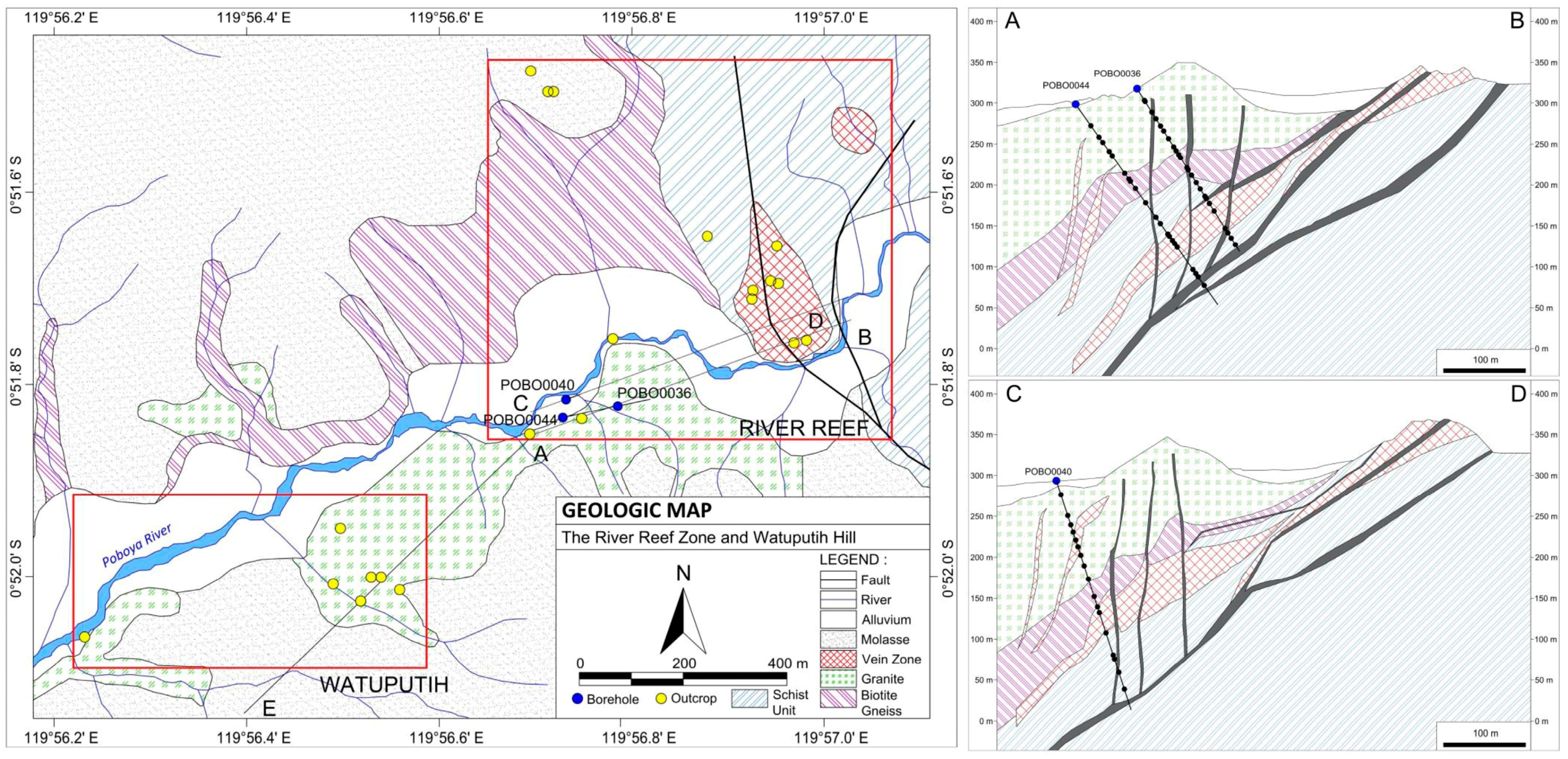

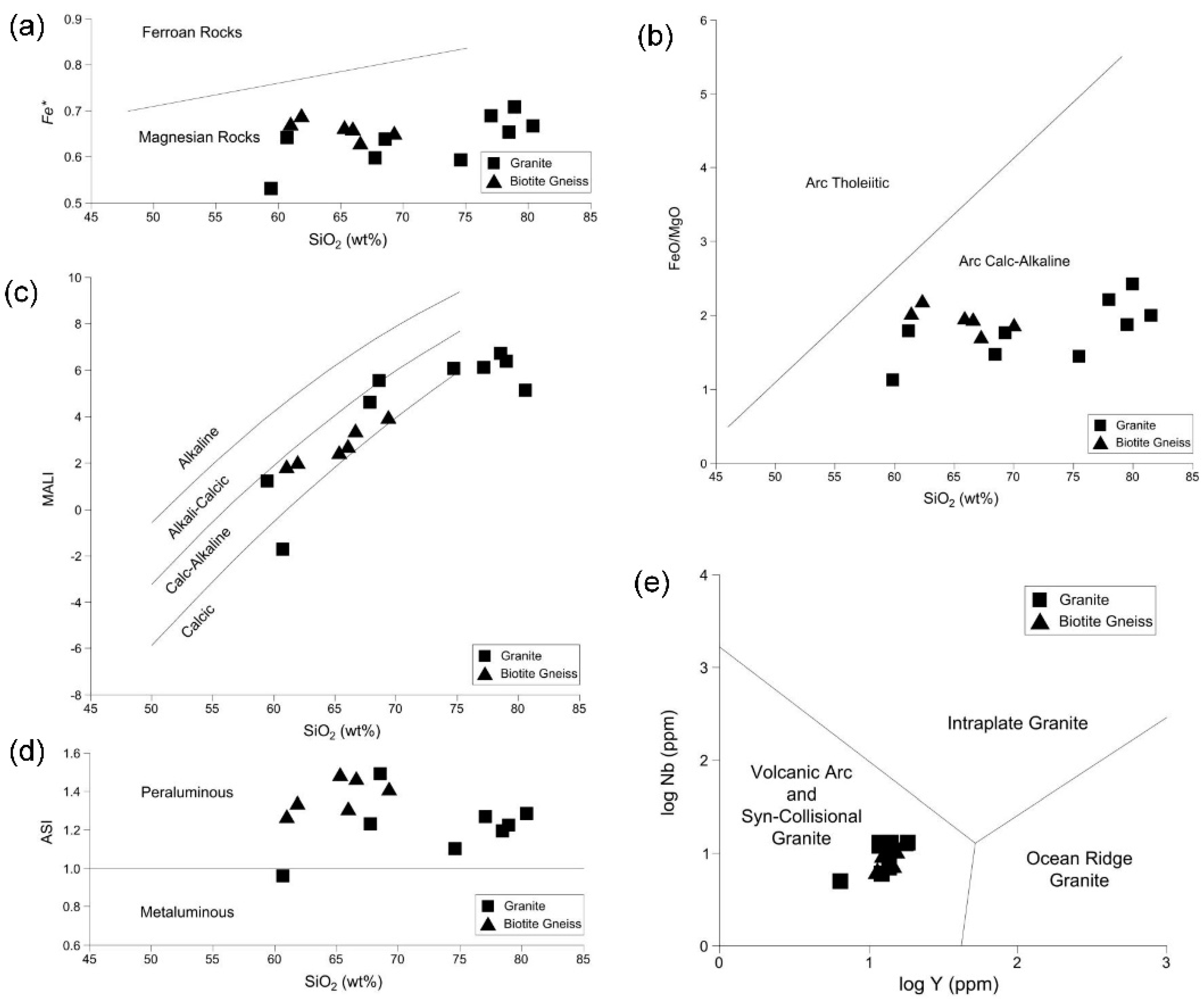
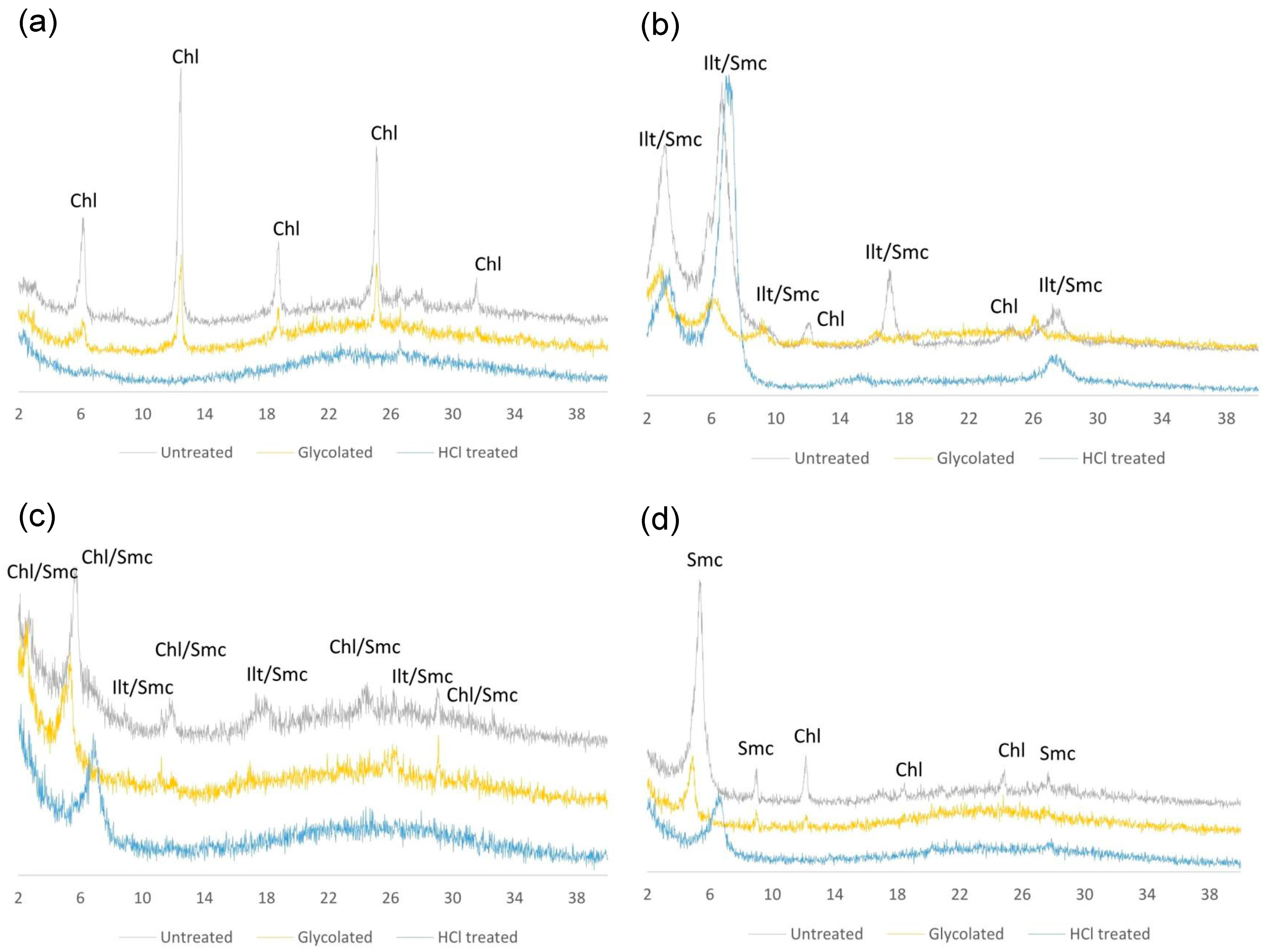
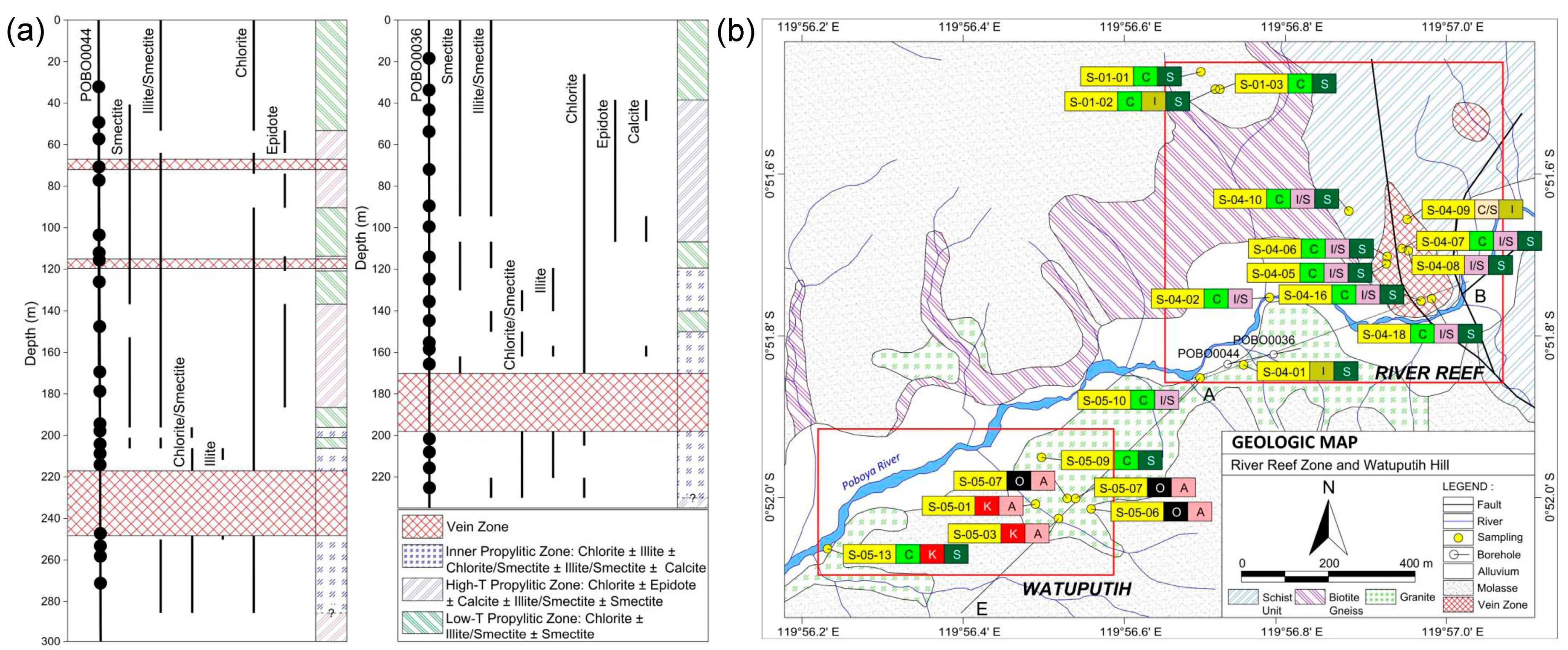
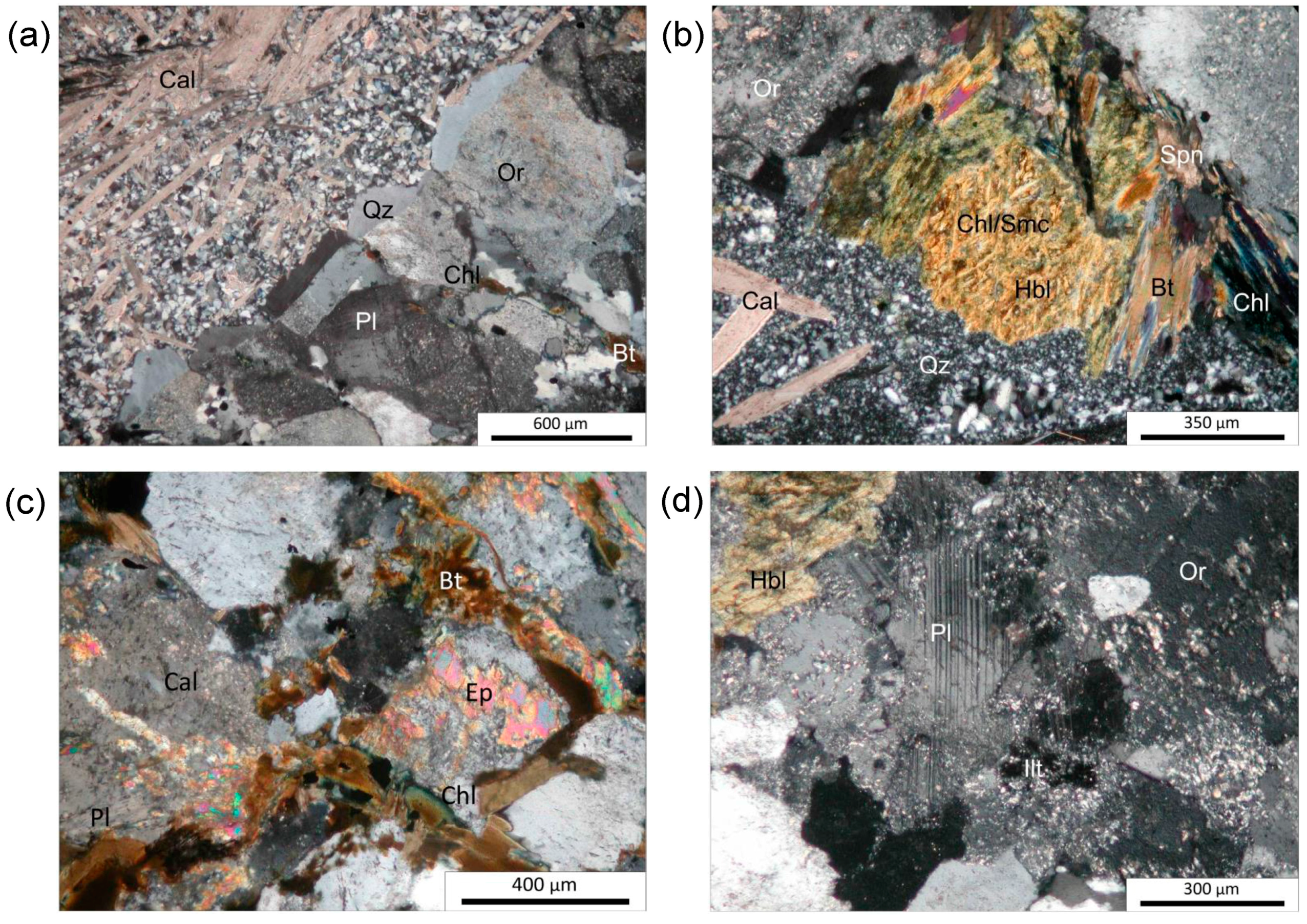
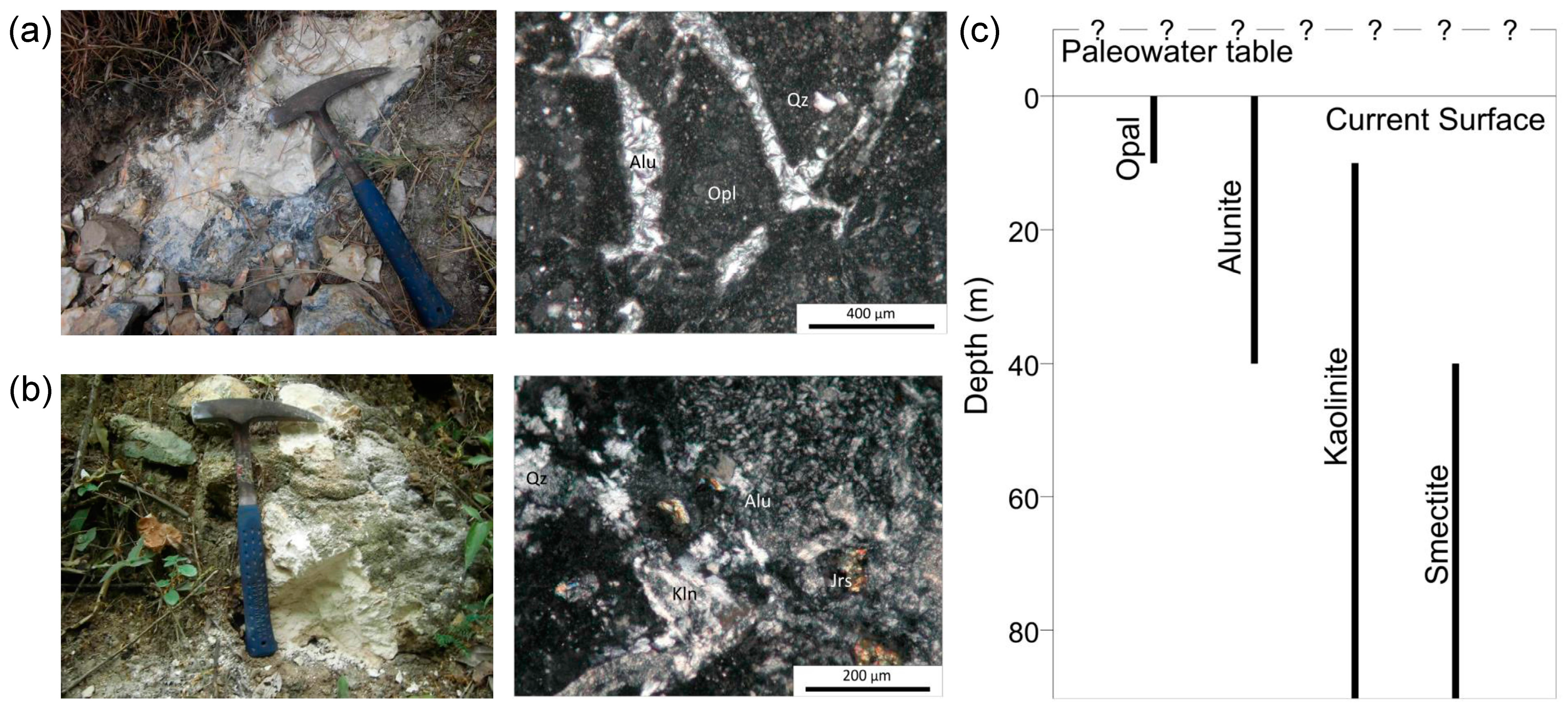

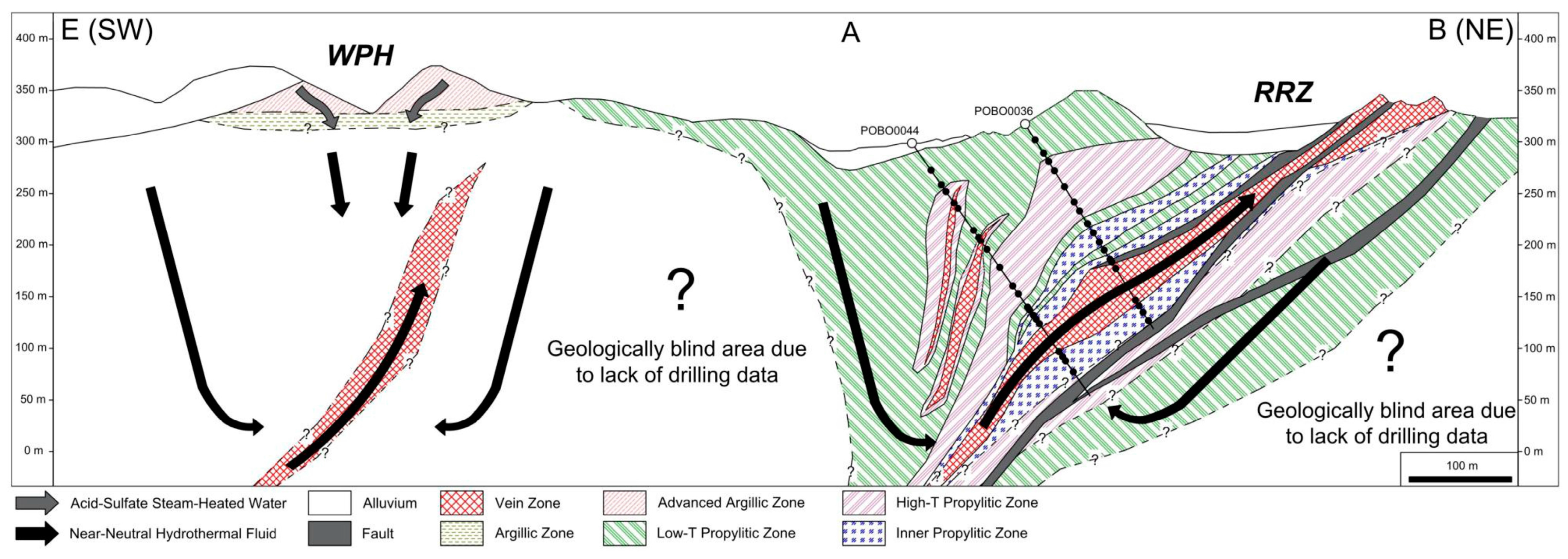
| Rock Type | LOD | Granite | Biotite Gneiss | Biotite Schist | Feldspar Porphyroblastic Biotite Schist | Amph Schist | ||||||||||||||||||
|---|---|---|---|---|---|---|---|---|---|---|---|---|---|---|---|---|---|---|---|---|---|---|---|---|
| Sample | 36-01 | 36-07 | 36-08 * | 36-09 * | 36-11 * | 40-10 * | 40-01 | 40-04 | 40-06 | 40-16 * | 36-13 * | 36-14 | 40-24 | 40-26 * | 40-29 * | 36-20 | 36-22 | 40-47 | 36-24 | 40-36 | 40-42 | 40-45 | 40-41 | |
| SiO2 (wt %) | 0.02 | 60.7 | 74.6 | 78.5 | 78.9 | 69.3 | 80.4 | 59.4 | 67.7 | 68.5 | 77.0 | 61.8 | 61.0 | 65.3 | 66.6 | 66.0 | 63.4 | 63.7 | 65.3 | 56.6 | 66.0 | 63.2 | 66.2 | 50.0 |
| TiO2 | 0.003 | 0.67 | 0.21 | 0.20 | 0.21 | 0.56 | 0.25 | 1.09 | 0.60 | 0.68 | 0.31 | 1.11 | 0.92 | 0.89 | 0.87 | 0.78 | 0.81 | 0.61 | 0.78 | 1.10 | 1.00 | 0.68 | 0.49 | 1.42 |
| Al2O3 | 0.02 | 12.8 | 11.4 | 11.0 | 10.9 | 14.1 | 9.9 | 20.0 | 13.5 | 14.2 | 11.6 | 16.4 | 15.4 | 14.9 | 14.4 | 14.5 | 14.8 | 13.1 | 15.1 | 14.7 | 12.0 | 15.0 | 14.8 | 14.1 |
| FeO | 0.004 | 3.52 | 1.11 | 1.14 | 1.28 | 3.25 | 1.18 | 3.35 | 2.86 | 3.31 | 1.67 | 5.38 | 5.11 | 4.59 | 3.95 | 4.27 | 6.25 | 4.22 | 5.63 | 5.97 | 4.95 | 3.31 | 2.92 | 10.33 |
| MnO | 0.002 | 0.13 | 0.08 | 0.06 | 0.03 | 0.09 | 0.05 | 0.12 | 0.08 | 0.07 | 0.13 | 0.15 | 0.16 | 0.12 | 0.06 | 0.08 | 0.09 | 0.09 | 0.11 | 0.12 | 0.05 | 0.04 | 0.06 | 0.16 |
| MgO | 0.03 | 2.0 | 0.8 | 0.6 | 0.5 | 1.8 | 0.6 | 3.0 | 1.9 | 1.9 | 0.8 | 2.5 | 2.6 | 2.4 | 2.4 | 2.2 | 4.2 | 3.6 | 3.8 | 4.7 | 3.8 | 3.6 | 2.4 | 8.9 |
| CaO | 0.001 | 7.013 | 1.644 | 0.306 | 0.343 | 2.281 | 0.532 | 2.840 | 2.059 | 1.140 | 0.595 | 4.357 | 4.460 | 3.157 | 2.725 | 3.674 | 3.083 | 2.785 | 0.521 | 5.041 | 2.887 | 2.383 | 2.558 | 8.768 |
| Na2O | 0.02 | 2.6 | 1.1 | 2.5 | 2.3 | 2.7 | 2.0 | 1.2 | 3.6 | 2.6 | 2.5 | 3.4 | 3.1 | 2.7 | 2.2 | 2.5 | 1.7 | 0.9 | 0.4 | 1.6 | 1.4 | 2.5 | 2.7 | 1.5 |
| K2O | 0.003 | 2.66 | 6.64 | 4.59 | 4.40 | 3.46 | 3.67 | 2.82 | 3.08 | 4.14 | 4.25 | 2.86 | 3.12 | 2.84 | 3.83 | 3.79 | 2.48 | 5.89 | 4.09 | 5.74 | 3.70 | 4.74 | 4.61 | 0.84 |
| P2O5 | 0.003 | 0.20 | 0.03 | 0.05 | 0.03 | 0.18 | 0.05 | 0.18 | 0.17 | 0.19 | 0.05 | 0.35 | 0.32 | 0.29 | 0.31 | 0.36 | 0.18 | 0.16 | 0.11 | 0.67 | 0.61 | 0.38 | 0.25 | 0.11 |
| LOI | - | 6.66 | 2.06 | 0.74 | 0.85 | 1.85 | 1.13 | 5.41 | 3.40 | 2.52 | 0.99 | 1.33 | 2.97 | 2.26 | 1.89 | 1.09 | 2.82 | 4.01 | 3.96 | 2.89 | 2.81 | 3.12 | 2.35 | 3.44 |
| Total | 98.9 | 99.6 | 99.6 | 99.8 | 99.6 | 99.7 | 99.4 | 99.0 | 99.2 | 99.8 | 99.7 | 99.0 | 99.3 | 99.2 | 99.2 | 99.8 | 99.1 | 99.7 | 99.1 | 99.1 | 98.8 | 99.4 | 99.6 | |
| S (ppm) | 30 | 9250 | 2030 | 2910 | 1430 | 1630 | 1670 | 3360 | 8460 | 5970 | 510 | 910 | 7350 | 4420 | 5450 | 4540 | 520 | 7570 | 1920 | 1370 | 6170 | 6640 | 1280 | 2780 |
| V | 15 | 70 | 30 | n.d. | 20 | 80 | 20 | 150 | 70 | 90 | 30 | 170 | 140 | 140 | n.d. | 110 | 150 | 120 | 160 | 170 | 140 | 100 | 70 | 370 |
| Cr | 26 | n.d. | n.d. | n.d. | n.d. | n.d. | 30 | n.d. | n.d. | n.d. | n.d. | n.d. | n.d. | n.d. | 40 | 70 | 120 | 50 | 90 | 100 | 60 | 40 | n.d. | 310 |
| Co | 100 | n.d. | n.d. | n.d. | n.d. | n.d. | n.d. | n.d. | n.d. | n.d. | n.d. | n.d. | n.d. | n.d. | n.d. | n.d. | n.d. | n.d. | n.d. | n.d. | n.d. | n.d. | n.d. | n.d. |
| Ni | 15 | n.d. | n.d. | n.d. | n.d. | n.d. | 20 | n.d. | n.d. | n.d. | n.d. | n.d. | n.d. | n.d. | 20 | 30 | 60 | 30 | 60 | 40 | 40 | 30 | 20 | 80 |
| Cu | 5 | 5 | 6 | n.d. | 11 | n.d. | 17 | 6 | n.d. | n.d. | n.d. | 9 | 8 | 8 | 79 | 106 | 5 | 33 | 42 | 39 | 103 | 19 | 45 | 34 |
| Zn | 20 | 30 | 80 | 20 | n.d. | 30 | 40 | 60 | 50 | 40 | 90 | 60 | 70 | 70 | 30 | 70 | 50 | 60 | 60 | 80 | 30 | 50 | 60 | 60 |
| Pb | 15 | n.d. | 40 | n.d. | n.d. | 15 | n.d. | n.d. | n.d. | n.d. | n.d. | n.d. | 15 | n.d. | n.d. | n.d. | n.d. | 15 | 15 | 20 | n.d. | 30 | 50 | n.d. |
| As | 2 | n.d. | 6 | 27 | 6 | n.d. | 22 | n.d. | 6 | 91 | n.d. | n.d. | 19 | 32 | 93 | 41 | 3 | 74 | 60 | 4 | 192 | 278 | 17 | 93 |
| Mo | 30 | n.d. | n.d. | n.d. | n.d. | n.d. | n.d. | n.d. | n.d. | n.d. | n.d. | n.d. | n.d. | n.d. | n.d. | n.d. | n.d. | n.d. | n.d. | n.d. | n.d. | n.d. | n.d. | n.d. |
| Rb | 3 | 79 | 295 | 139 | 131 | 96 | 108 | 102 | 95 | 158 | 127 | 116 | 126 | 118 | 124 | 116 | 111 | 280 | 216 | 182 | 183 | 169 | 138 | 46 |
| Sr | 3 | 372 | 153 | 81 | 108 | 457 | 121 | 235 | 318 | 316 | 116 | 665 | 685 | 553 | 475 | 607 | 288 | 235 | 24 | 1421 | 498 | 984 | 980 | 190 |
| Ba | 80 | 900 | 830 | 450 | 400 | 1660 | 150 | 1200 | 1130 | 1390 | 790 | 1050 | 1000 | 890 | 1380 | 1620 | 490 | 720 | 250 | 4870 | 780 | 3130 | 3160 | 110 |
| Y | 2 | 42 | 24 | 29 | 11 | 23 | 25 | 30 | 24 | 29 | 29 | 39 | 30 | 26 | 31 | 33 | 38 | 23 | 28 | 55 | 43 | 33 | 27 | 35 |
| Zr | 4 | 269 | 105 | 188 | 76 | 244 | 110 | 273 | 262 | 286 | 169 | 401 | 333 | 336 | 303 | 328 | 171 | 131 | 149 | 444 | 406 | 309 | 246 | 87 |
| Nb | 3 | 13 | 13 | 7 | 5 | 6 | 6 | 13 | 12 | 13 | 8 | 12 | 10 | 9 | 7 | 10 | 10 | 6 | 9 | 19 | 16 | 13 | 13 | n.d. |
| Location | LOD | Peak | Hillside | ||||
|---|---|---|---|---|---|---|---|
| Sample | 06-01 | 07-01 | 08-01 | 01-01 | 03-01 | 03-02 | |
| SiO2 (wt %) | 0.02 | 89.5 | 96.4 | 91.3 | 55.4 | 62.5 | 56.3 |
| TiO2 | 0.003 | 1.14 | 0.25 | 3.4 | 0.16 | 0.77 | 0.41 |
| Al2O3 | 0.02 | 2.7 | 0.4 | 0.8 | 16.6 | 16.3 | 14.7 |
| FeO | 0.004 | 0.53 | 0.41 | 0.56 | 0.58 | 1.23 | 2.5 |
| MnO | 0.002 | n.d. | n.d. | n.d. | n.d. | n.d. | n.d. |
| MgO | 0.03 | 0.3 | 0.3 | 0.3 | 0.3 | 0.8 | 0.3 |
| CaO | 0.001 | 0.253 | 0.090 | 0.171 | 0.105 | 0.208 | 0.082 |
| Na2O | 0.02 | 0.5 | 0.3 | 0.4 | 0.4 | 1.1 | 0.4 |
| K2O | 0.003 | 0.36 | 0.03 | 0.05 | 2.57 | 2.82 | 2.45 |
| P2O5 | 0.003 | 0.33 | n.d. | 0.07 | 0.08 | 0.15 | 0.05 |
| LOI | - | 3.22 | 1.83 | 2.88 | 18.03 | 11.34 | 17.15 |
| Total | 98.8 | 100 | 99.9 | 94.2 | 97.2 | 94.3 | |
| S (ppm) | 30 | 9700 | 250 | 530 | 56210 | 26510 | 55740 |
| V | 15 | 60 | 20 | 180 | 50 | 110 | 60 |
| Cr | 26 | n.d. | n.d. | n.d. | n.d. | n.d. | n.d. |
| Co | 100 | n.d. | n.d. | n.d. | n.d. | n.d. | n.d. |
| Ni | 15 | n.d. | n.d. | n.d. | n.d. | n.d. | n.d. |
| Cu | 5 | n.d. | n.d. | n.d. | n.d. | 7 | 7 |
| Zn | 20 | n.d. | n.d. | n.d. | n.d. | n.d. | n.d. |
| Pb | 15 | 50 | n.d. | n.d. | 30 | n.d. | n.d. |
| As | 2 | n.d. | 5 | 3 | n.d. | n.d. | n.d. |
| Mo | 30 | n.d. | n.d. | n.d. | n.d. | n.d. | n.d. |
| Rb | 3 | n.d. | n.d. | n.d. | 24 | 108 | 22 |
| Sr | 3 | 708 | n.d. | 89 | 176 | 191 | 92 |
| Ba | 80 | 870 | n.d. | 170 | 1280 | 1050 | 830 |
| Y | 2 | 5 | 3 | 4 | 4 | 22 | 4 |
| Zr | 4 | 321 | 155 | 286 | 108 | 264 | 246 |
| Nb | 3 | 20 | 6 | 21 | 6 | 11 | 6 |
© 2017 by the authors. Licensee MDPI, Basel, Switzerland. This article is an open access article distributed under the terms and conditions of the Creative Commons Attribution (CC BY) license (http://creativecommons.org/licenses/by/4.0/).
Share and Cite
Syafrizal; Rivai, T.A.; Yonezu, K.; Kusumanto, D.; Watanabe, K.; Hede, A.N.H. Characteristics of a Low-Sulfidation Epithermal Deposit in the River Reef Zone and the Watuputih Hill, the Poboya Gold Prospect, Central Sulawesi, Indonesia: Host Rocks and Hydrothermal Alteration. Minerals 2017, 7, 124. https://doi.org/10.3390/min7070124
Syafrizal, Rivai TA, Yonezu K, Kusumanto D, Watanabe K, Hede ANH. Characteristics of a Low-Sulfidation Epithermal Deposit in the River Reef Zone and the Watuputih Hill, the Poboya Gold Prospect, Central Sulawesi, Indonesia: Host Rocks and Hydrothermal Alteration. Minerals. 2017; 7(7):124. https://doi.org/10.3390/min7070124
Chicago/Turabian StyleSyafrizal, Tomy Alvin Rivai, Kotaro Yonezu, Damar Kusumanto, Koichiro Watanabe, and Arie Naftali Hawu Hede. 2017. "Characteristics of a Low-Sulfidation Epithermal Deposit in the River Reef Zone and the Watuputih Hill, the Poboya Gold Prospect, Central Sulawesi, Indonesia: Host Rocks and Hydrothermal Alteration" Minerals 7, no. 7: 124. https://doi.org/10.3390/min7070124





